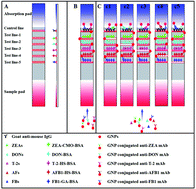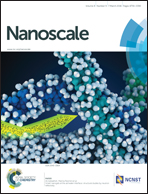A gold nanoparticle-based semi-quantitative and quantitative ultrasensitive paper sensor for the detection of twenty mycotoxins†
Abstract
A semi-quantitative and quantitative multi-immunochromatographic (ICA) strip detection assay was developed for the simultaneous detection of twenty types of mycotoxins from five classes, including zearalenones (ZEAs), deoxynivalenols (DONs), T-2 toxins (T-2s), aflatoxins (AFs), and fumonisins (FBs), in cereal food samples. Sensitive and specific monoclonal antibodies were selected for this assay. The semi-quantitative results were obtained within 20 min by the naked eye, with visual limits of detection for ZEAs, DONs, T-2s, AFs and FBs of 0.1–0.5, 2.5–250, 0.5–1, 0.25–1 and 2.5–10 μg kg−1, and cut-off values of 0.25–1, 5–500, 1–10, 0.5–2.5 and 5–25 μg kg−1, respectively. The quantitative results were obtained using a hand-held strip scan reader, with the calculated limits of detection for ZEAs, DONs, T-2s, AFs and FBs of 0.04–0.17, 0.06–49, 0.15–0.22, 0.056–0.49 and 0.53–1.05 μg kg−1, respectively. The analytical results of spiked samples were in accordance with the accurate content in the simultaneous detection analysis. This newly developed ICA strip assay is suitable for the on-site detection and rapid initial screening of mycotoxins in cereal samples, facilitating both semi-quantitative and quantitative determination.

- This article is part of the themed collection: Editor’s Choice: Making sense of nanosensors and devices


 Please wait while we load your content...
Please wait while we load your content...